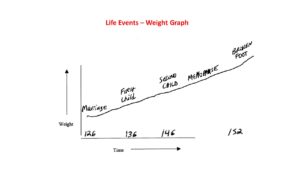Before I help patients develop a personalized weight loss plan, I want to better understand each person’s weight journey – and how they got to where they are today.
To do that I use a technique where I ask patients to plot their weight at different times of their life. For most patients, they are able to recall associated life events that influenced their body weight. Here are some common examples:
- going away to college
- getting married
- starting a new job
- relocating
- getting pregnant
- having children
- suffering an illness or injury
- having a sick child
- losing a job
- becoming an empty nester
- caring for an aging parent
- getting a divorce
- going through menopause
- having a death in the family
- starting a new medication
Although the listed weights may just be estimates, the effect of the life event and pattern of weight change is recalled by the majority of patients I see.
Here is one graph example:

This ‘Life Events Weight Graph’ exercise can be quite revealing. In one place, people get a snapshot of their personal weight journey.
I encourage you to do this same exercise. You can draw 2 lines on a piece of paper with the vertical line being weight and the horizontal line being time. Then you want to fill in your life events and weight.
Here are 3 things you can learn from doing this exercise:
1 – You can see all the multiple factors in life that can affect one’s weight. Managing one’s weight is complex and not just about the food on your plate. Also, there is no role for shaming or blaming yourself.
2 – You can make more specific connections between weight gain and other life changes such as a change in your physical health that caused joint pain or less mobility, or a stressful time when you grieved the loss of a loved one or after giving birth when your time was given away to others or getting a new job with a long commute.
3- You can use this as a reflective and educational tool for moving forward and making positive changes. I encourage patients to discuss things they remember doing at certain stages of life when they were able to maintain a healthier weight. And then we discuss what got in the way and led to weight gain.
Spending time understanding the past provides a treatment direction for the future.
I hope this graph exercise helps you bring more self-compassion and understanding to your weight journey.
Enjoy your health!
RK
Robert Kushner, MD

Thank you for those recommendations. This approach can also be used in Pediatrics. I am a pediatrician who works with families and their children who are referred to the Nutrition and Fitness for Life clinic in Boston to improve their lifestyles. One of the first questions I ask is why the family decided to come to my office, what if any concerns they and/or their pediatrician have, and whether they have any specific goals for this visit. Then, I ask the parent or child or both (based on age) if they can identify a time when the patient started gaining weight faster than expected. Like you mentioned, the family is able to identify one or more events. They moved from another country, the family lost a job, the family separated, a parent was deported, the family became homeless, the patient was teased at school, they changed schools, the patient wanted to eat like their classmates, a neighbour was shot, the pandemic hit, … Then, the family starts thinking about what happened. They realize they cannot change the event but they recognize the impact of the event on their lifestyles. They start thinking about ways they could help the patient get healthier.